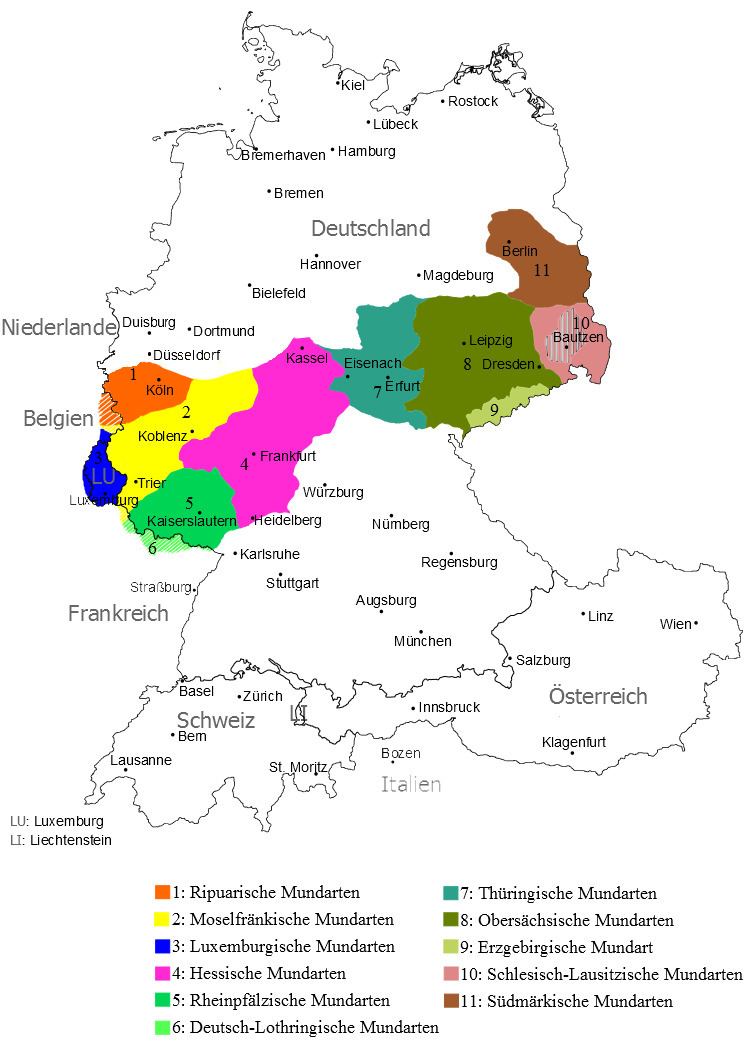Native speakers 2 million (1998) Glottolog uppe1400 | ISO 639-3 sxu | |
 | ||
Language family Indo-EuropeanGermanicWest GermanicHigh GermanCentral GermanEast Central GermanUpper Saxon | ||
Upper Saxon (German: Obersächsisch) is an East Central German dialect spoken in much of the modern German State of Saxony and in the adjacent parts of Saxony-Anhalt and Thuringia. Though colloquially called "Saxon" (Sächsisch), it is not to be confused with the Low Saxon dialect group in Northern Germany. Upper Saxon is closely linked to the Thuringian dialect spoken in the adjacent areas to the west.
Contents
History
The Upper Saxon dialect evolved as a new variety in the course of the medieval German Ostsiedlung (eastern settlement) from about 1100 onwards. Settlers descending from the stem duchy of Saxony speaking Old Saxon, but also from Thuringia, moved into the Margraviate of Meissen beyond the Elbe and Saale rivers then populated by Polabian Slavs. The importance of the Upper Saxon chancery German rose with establishment of the Saxon electorate. In the context of the Bible translation by Martin Luther, it played a large part in the development of the Early New High German language as a standard variety.
Spoken by leading communists descending from the Central German industrial area like Walter Ulbricht, the Upper Saxon dialect was commonly perceived as the colloquial language of East Germany by West German citizens and up to today is a subject of numerous stereotype jokes. The mildly derogatory verb sächseln means to speak/sound Saxon.
Accent
The most notable distinguishing feature of the dialect is that the letters o and u are pronounced as centralized vowels ([ɞ] and [ɵ], respectively, when short; [ɵː] and [ʉː], respectively, when long). Speakers of other German dialects that do not have these sounds tend to perceive these sounds as being ö [øː] and ü [yː] respectively. For example, they hear [ʔæʉs] 'out' as if written aüs (Standard aus [ʔaʊs]) and [ˈʔɵːma] 'grandma' as if written Öma (Standard Oma [ˈʔoːma]). Front rounded vowels are pronounced as non-rounded (ö = [eː], ü = [iː]). Final -er is pronounced [ɔ̴] (or similarly, depending on the subdialect), which speakers of other German dialects tend to hear as [oː]; e.g. [ˈheːɔ̴] 'higher' (Standard [ˈhøːɐ̯] höher) is misheard as if written he(h)o.
The Upper Saxon dialects outside the Ore Mountains can be easily recognized by the supposed "softening" (lenition) of the voiceless stop consonants /p/, /t/ and /k/. Speakers of other dialects hear these as if they were "b", "d" and "g" respectively. In reality, these are merely non-aspirated versions of the same /p/, /t/ and /k/, a widespread feature among Central German dialects, as opposed to strongly aspirated [pʰ], [tʰ] and [kʰ] in dominant German dialects.
Subgroups
The degree of accent varies from place to place, from a relatively mild accent in the larger cities such as Dresden or Chemnitz to a stronger form in rural areas, depending on the grade of the High German consonant shift:
